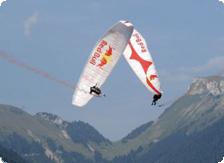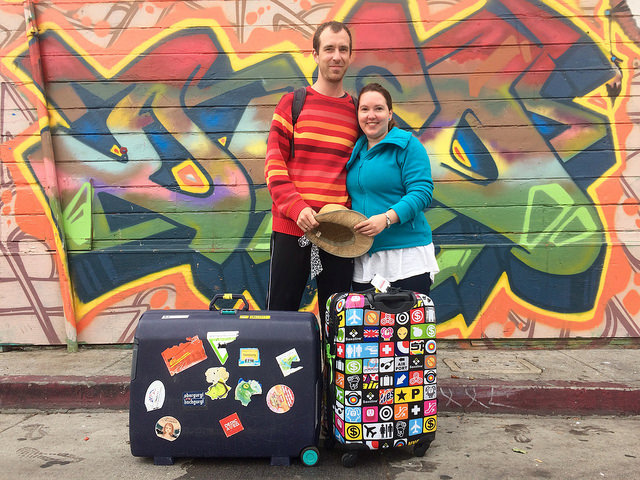by Shanti Sosienski
“We just might fly today,” says Chris Santacroce, 31, owner of Superfly Paragliding Academy in Salt Lake City, Utah. “Santa,” as he’s referred to in the paragliding community, and I are standing at South Point, a muddy, somewhat snow-covered parking lot on the top of a long sloping hill.
It’s hard to believe this is the Mecca of the North American paragliding scene. To me, it looks more like the kind of place I remember hanging out at in high school for keg parties. It’s just an empty dirt parking lot atop ugly terrain situated on a hill above a gravel pit.
All day long, dump trucks pull in and out of the area, loaded with dirt that will help expand Salt Lake City’s largest and most generic-looking housing project just to the north of where we are standing. Interstate 15 hums below, but we’re almost invisible to the average person cruising down the gray ribbon of concrete that travels north and south. But to a paraglider, this is it—the I Have Arrived. This ugly mountaintop is the proving ground for all fliers, from beginners to the best.
“Everybody at one point or another in their years of flying comes here, and most people who are avid flyers come at least once a year to help start their summer season off right,” explains Santa as we unload gear from his car. Gear includes paraglider, helmet, radio, and a soft snail shell of a contraption called a harness, which I can’t help but laugh at when I see it on other people. Once buckled in, “pilots,” as they are called, waddle around like cartoon bugs walking upright, setting up the rest of their gear. Helmet on, harness tight, I pull out my paraglider. Also known as a wing, these giant kites live most of their lives neatly folded in an opaque stuff-sack until pulled out and placed carefully on the ground in the shape of a horseshoe in preparation for flight.
You don’t have to be a rocket scientist to figure out that paragliders are a weird mix of people. The average paraglider is forty, male, and usually ithe kind of guy who has some money to spare and a job that gives him free time. Firefighters, doctors, and teachers are typical enthusiasts. Hang out at the Point and chances are you’ll meet an uber-rich thrill-seeker who just Lear-jetted in for the day to get a few practice flights, while the guy standing next to him might be considered a bum because he sleeps in his car and sells weed to support his flying habit.
As we set up, I meet a few of Santa’s friends from Breckenridge, Colorado. They have that hearty, ski-patrol look of tan faces and white, toothy grins, but because Doug is on his Nextel phone with his boss acting like he is on a job site, I learn that they are in construction. I hear him say he won’t be coming into the office today, but the site looks fine and not to worry. He hangs up with a delighted chuckle. The Point is a seven-hour drive away from his job site in Breckenridge.
Every year guys like these, and at least a few hundred other of the 4,000 registered paragliders in North America, make the pilgrimage to the Point because it’s where you go to get your flying “dialed in.” A combination of geography and easy access is what makes this The Spot. Like a river that has that sweet, fast point when water flows between two rocks, this area is where two valleys, each with one hundred miles of empty terrain on either side, come together. The wind whips smoothly through—a perfect, consistent fourteen to fifteen miles per hour, lighter in winter, stronger in summer. It’s predictable, smooth soaring, and the terrain is wide open.
On any given balmy summer day, over forty pilots can be found gliding this ridge, performing an almost aerial ballet that makes paragliding appear so dreamy to spectators. And of those forty, at least five paragliders regularly live in their cars at the Point for weeks on end, earning the name “Point Rats” for the duration of their stay. Even in the winter, a handful of gliders hang out here regularly, despite the fact that it’s twenty degrees outside.
On this cold winter afternoon, cars or trucks arrive every twenty minutes. A guy gets out, checks the air and the view, then makes a choice to fly or not. It’s strangely reminiscent of a super-sick surf spot, yet when the gliders get out of their cars to look, they are looking at nothing because you can’t see air. Flying is all about feeling and calculated guesses, and it’s this that keeps most fliers humble. Get too cocky and the gods or mother nature or whatever you believe in will strike you down.
“Even though it’s a dirty, dusty little hill, it humbles people,” Santa says, smiling and looking out at the horizon. In spite of the fact that we are supposed to be having fun, there is always a serious air about the place and this scene; I feel it. I want to jump around like a five-year-old because what I am doing seems spectacular, daring, exciting, but Santa is quick to remind me that it’s just another day of being a “ding-aling string.”
I nod with understanding, roping my enthusiasm back in, remembering that morning when I learned the fundamentals: always look at the horizon, never down at the ground, always smile and say “awesome,” because flying never sucks. This along with remembering to never talk about flying—it’s not cool. Don’t brag. Don’t talk about wind or conditions when you arrive at a spot. If you have to ask what’s happening here, you haven’t done your homework prior to coming to the Point. Homework entails looking up the wind conditions on the internet and then reading the landscape when you arrive. I get it. “Air is invisible and it always changes, so you need to always go into paragliding knowing that no two flights will ever be the same,” says Santa.
I am ready for my final flight of the evening. The wind whips from the south coldly against my face as I start running toward the downhill slope. “Run, run, run—now lighter steps!” I hear Santa yelling as I take off…and then I am flying. The ground drops out below me and reminds me of a dream I have had all of my life where I am in the air, freely soaring like a bird. Apparently, paragliders believe that people who have this dream a lot in their life are meant to fly. I alternate between feeling at home and a little scared and nervous. No one but Santa is paying attention to me. I want to let out a triumphant whoop of excitement, but I have a feeling that’s not in the cool category in the unspoken paragliders’ etiquette manual.
I make a few figure eights, turning in toward the hill, listening for my instructor on the radio and making a note of where other paragliders are around me. Heading toward the ground is inevitable, because no matter what, gravity always wins. I touch down with a little butt check—not a perfect landing, but I am impressed with myself anyway. I look around for an audience. I want applause, I want someone to be in awe that I was just flying, but there is no one there. And this is what paragliding is all about. High above, two gliders soar and I watch them, cool and calm, then turn toward my glider, roll it up carefully as I have been taught, and wait for Santa to pick me up. “Nice flight. We have to work on that landing. I’ll be right down to get you.”
Interested in learning to paraglide at the Point? Give Superfly Paragliding Academy a call. They offer courses throughout the year in Salt Lake City, but also have a handful of courses in Southern California, Colorado, Mexico, and Italy. To find out more information on dates go to www.superfly.com—note that they also have women only courses! A five-day lesson will run you about $850, and a total package of eight days of lessons to get licensed is $1500. Harness, glider, and reserve chute generally cost around $4,000.
For more about the author, visit her website at www.shantisos.com
And to learn more about that darling instructor in these pictures, check out www.4superfly.com







